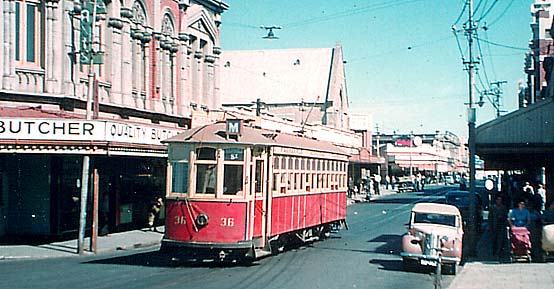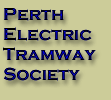
Trams in Western Australia:
|
|
| The port of Fremantle, founded in 1829, is situated at the mouth of the Swan River. Perth, the capital city of Western Australia, is 15 kilometres upstream. After many years of slow growth in Western Australia, the gold discoveries of the 1890s produced a sudden increase in population, many of the new migrants arriving through Fremantle.
As the population growth stabilised by around 1900, state and local authorities realised that public utilities and infrastructure were required for further growth. Provision of an electricity supply and public transport were two of the important areas, and after many proposals which did not come to fruition, the Fremantle and East Fremantle Councils eventually decided jointly to form the Fremantle Municipal Tramways and Electric Lighting Board (FMT&ELB) to fulfill both of these needs. The system opened in October, 1905, and by April 1906 the initial routes, centred on the Fremantle Railway Station, were
Initially there were 14 single-truck trams in operation, of the California combination type. |
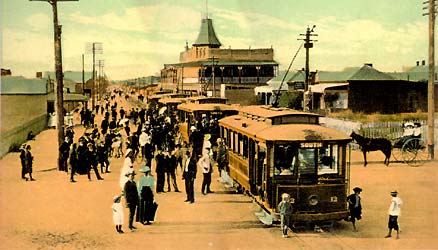 |
| Crowds returning to Fremantle from South Beach on the then new Fremantle trams, c. 1906. |
| The North Fremantle Council soon joined the scheme, buying two trams and extending the track across the Swan River along Perth-Fremantle Road [now Stirling Highway] to Leighton St. This became the "North" route, opened in September 1908.
Further route extensions were
|
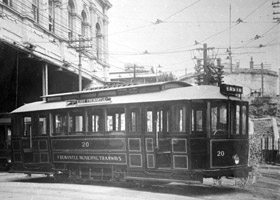 |
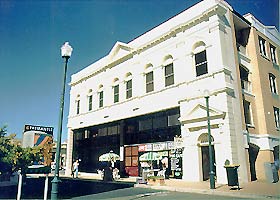 |
|
| The original Carbarn was constructed at the end of High St, just opposite the Roundhouse.
Car number 20 is seen outside the Carbarn. |
The facade of the Carbarn, now forming part of a residential development. |
| The Melville Roads Board joined the undertaking, resulting in the Canning Highway line being extended to the Board's Offices at Stock Road, with a branch to the popular Swan River picnic and entertainment area at Point Walter.
By 1923 there were 28 trams in service, and a new Carbarn had been built in Queen Victoria St to supplement the original one in High St. The Fremantle tramways were a visible expression of civic pride - they were highly successful and became an integral part of Fremantle life. Not only for work and shopping in the city, the tramways also provided access to leisure activities at South Beach and Point Walter, sporting and racing venues, and later to the movies. The excellent standard of maintenance and presentation of the trams was no doubt linked to the Board's policy that all operational staff should live locally, which led to a high degree of rapport with the passengers. |

FMT 11 as converted to saloon form from the original California combination.
As was also the case elsewhere, the war effort took its toll on the tramway, in terms of lack of maintenance coupled with greatly increased demand, but in the case of Fremantle this was not the main factor in its subsequent closure. The FMT&ELB's tramway and electricity operations were always profitable overall. However, from 1936 onwards the tramways alone did not produce a profit. When, in 1952, the State Electricity Commission took over the electricity supply in Fremantle the tramway was unable to survive on its own, and the last tram ran on November 8 of that year.
The number of passengers carried in 1930 was 6.27 million, a remarkable number considering that the population of the area was about 30 000. From 1931 the passenger numbers decreased as the effects of the depression were felt, but the tramways remained profitable. Passenger numbers did not recover until the war, reaching 9 million in 1943. New tramcars continued to be built, the latest being 1935 tramcar #36 - this was the last tram ever built for Western Australia.
This table gives some information about the tramcars in the Fremantle fleet.
Fremantle Tramcars
Tramcar
numbers
In service
Capacity
Description
1 - 14
1905-6
40 seats
Single truck, drop-end, open California combination.
Body: JG Brill, USA
15-16
1908
40 seats
Single truck, drop-end, open California combination.
Body:Westralia Ironworks, Fremantle
17-19
1910
40 seats
Single truck, drop-end, open California combination.
Body: JG Brill, USA
20-21
1912
40 seats
Single truck, drop-end, closed combination.
Body: Bolton's, WA
22
1915
38 seats
Single truck, drop-end, closed combination.
Body: Bolton's, WA
23
1915
75 seats
Bogie, open cross-bench
Body: Bolton's
24-25
1913
40 seats
Single truck, drop-end, open California combination.
Body: Bolton's
7, 4, 11
1920-21
40seats
Single truck saloon
Body: Fremantle Municipal Tramways, WA
Converted from earlier form
26-29
1921
64 seats
Bogie saloon
Body: WA Government Railways Workshops, Midland Junction
30-32
1925
64 seats
Bogie saloon
Body: Bolton's
33
1927
64 seats
Bogie saloon
Body: FMT
34
1930
64 seats
Bogie saloon
Body: FMT
35
1932-33
64 seats
Bogie saloon
Body: FMT
23
1933-34
52 seats
Bogie saloon
Body: FMT
Converted from earlier form
36
1935
64 seats
Bogie saloon
Body: FMT
numbers
Body: JG Brill, USA
Body:Westralia Ironworks, Fremantle
Body: JG Brill, USA
Body: Bolton's, WA
Body: Bolton's, WA
Body: Bolton's
Body: Bolton's
Body: Fremantle Municipal Tramways, WA
Converted from earlier form
Body: WA Government Railways Workshops, Midland Junction
Body: Bolton's
Body: FMT
Body: FMT
Body: FMT
Body: FMT
Converted from earlier form
Body: FMT
